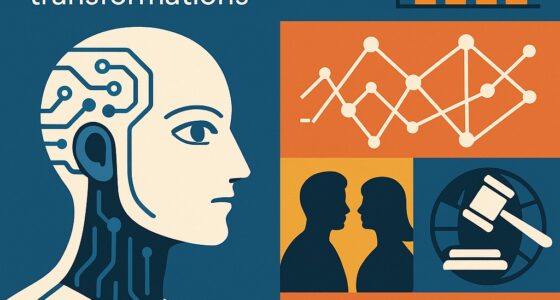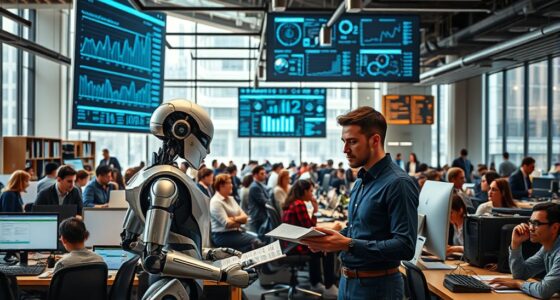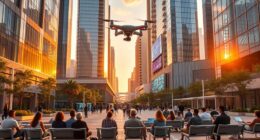AI is automating many jobs faster than new roles can be created, especially in routine, entry-level positions across industries. While some emerging roles in tech and data science offer new opportunities, millions face job losses and skills gaps. Regions adopting AI more quickly experience sharper labor shifts. To truly understand whether AI will ultimately create more jobs than it destroys, consider how policies, reskilling efforts, and global trends shape this ongoing transformation. If you want to see how this could unfold, continue exploring.
Key Takeaways
- AI is responsible for significant job displacement, especially in routine and entry-level roles across multiple industries.
- While new roles in AI and data science are emerging, the overall pace of job loss may outstrip new job creation initially.
- Rapid AI adoption risks widening the skills gap, requiring extensive reskilling and workforce adaptation efforts.
- Regions adopting AI faster tend to experience more pronounced employment shifts, challenging job market stability.
- Long-term benefits depend on effective policies, education reform, and investments in workforce retraining to offset job losses.
The Scale of Job Displacement Across Sectors

The scale of job displacement across sectors driven by AI is significant and rapidly evolving. In May 2023, AI caused 5% of all U.S. job losses, making it the seventh-largest contributor. The tech industry alone shed 136,831 jobs this year, the highest layoffs since 2001, mainly due to AI and automation. Telecommunications companies like British Telecom plan to cut 10,000 jobs over seven years because of AI-driven customer service chatbots. Manufacturing has also suffered, losing about 1.7 million jobs since 2000 due to automation, with robotic tools replacing many roles. Overall, about 19% of American workers face high AI exposure, especially those in routine, repetitive jobs. AI could replace approximately 800 million jobs worldwide by 2030. These trends show AI’s profound impact, causing widespread displacement across multiple sectors. Understanding workforce adaptation remains crucial as these shifts continue to unfold, especially in industries where toilet maintenance and repairs are essential for operational efficiency. Additionally, the integration of advanced home furnishings technology in workplaces might influence future employment patterns and safety protocols. As the adoption of AI-driven processes accelerates, it is vital for workers to develop skills that complement automation rather than compete with it. Recognizing the importance of reskilling and upskilling can help mitigate the negative effects of displacement and prepare the workforce for emerging opportunities.
Emerging Opportunities and New Roles in the AI Era

As AI continues to advance, new job opportunities are rapidly emerging across diverse industries. You’ll notice a surge in AI-related roles, with over 9.5% of all software development jobs now focused on AI. The share of AI positions has grown by 21% since 2018, reflecting the technology’s rapid adoption. Roles like machine learning engineers, data scientists, and AI ethics specialists are in high demand. Industries beyond tech, such as banking and logistics, are hiring more AI professionals—major banks increased their AI headcount by 13% in just six months. These jobs require a broad skill set, blending technical expertise with creative problem-solving. Companies are also investing in training programs, emphasizing continuous learning to keep pace with evolving AI technologies. Incorporating specialized voiceover skills into AI-driven content creation is becoming an innovative avenue for professionals. Additionally, understanding the importance of adaptability is crucial as the AI landscape continues to evolve rapidly. Moreover, recognizing the AI security vulnerabilities and ethical considerations is vital for responsible deployment of these technologies. Staying informed about industry trends helps professionals remain competitive in this dynamic environment.
Impact on Entry-Level and Routine Jobs

AI is rapidly transforming entry-level and routine jobs across multiple industries, making roles that once served as essential stepping stones increasingly vulnerable to automation. Tasks like simple coding, debugging, document review, and customer service are now handled by AI tools, reducing opportunities for young workers. About 40% of employers plan workforce cuts due to automation, hitting entry-level roles hardest. While some workers are redeployed to more advanced tasks, many face limited career pathways, impacting social mobility. The table below shows key sectors affected:
| Sector | Jobs Most Impacted | Changes Observed |
|---|---|---|
| Software Development | Junior coding, debugging | Automation of routine tasks |
| Legal | Paralegals, legal assistants | Document review and analysis |
| Retail | Customer service, inventory management | Increased automation |
| Financial | Entry-level banking roles | Routine processing replaced |
| Other sectors | Various entry roles | Shifting skill demands |
Furthermore, the shift in job availability could hinder the ability of young workers to gain initial work experience, which is crucial for career progression. Additionally, the rapid adoption of AI technologies accelerates this impact by reducing the need for human oversight in many routine tasks. As automation becomes more prevalent, the skills gap between current worker capabilities and evolving job requirements is likely to widen, posing additional challenges for workforce development.
Global Variations in AI Adoption and Labor Shifts

Global adoption of AI varies markedly across regions, shaping how labor markets respond to automation. Emerging markets, especially India and the GCC, show rapid AI growth—India leads with 59% of companies deploying AI, while 76% of the GCC population actively uses AI services. These regions experience swift labor shifts, often with mixed job creation and destruction outcomes. The US remains a major player, adding 21 million new AI users in 2025, totaling 133 million, with China and Germany also expanding their user bases considerably. In contrast, Europe lags behind in AI adoption, resulting in slower labor market transformations. Governments in the GCC are heavily investing in AI for public services, accelerating sector shifts. Overall, regions adopting AI faster tend to see more pronounced labor market changes.
Skills Transformation and the Need for Workforce Reskilling

How can you keep pace with rapid technological changes and avoid skills obsolescence? The answer lies in continuous reskilling and upskilling. With 44% of your skills expected to be disrupted in the next five years, staying current is essential. Over 60% of workers will need retraining by 2027 to maintain relevance, and by 2026, up to 70% of jobs may change or disappear, requiring significant reskilling efforts. Employers increasingly prioritize skills-based hiring, with 81% adopting this approach. Investing in tailored training programs and integrating new technologies can help close skills gaps and boost productivity. Organizations that foster ongoing learning and development not only enhance their competitiveness but also improve employee retention, ensuring you remain adaptable amid constant technological evolution. Incorporating data-driven marketing strategies can further enhance your workforce’s ability to adapt and thrive in changing markets. Additionally, leveraging IRA investment strategies such as self-directed IRAs can provide alternative avenues for financial growth and security during periods of rapid change. Emphasizing the importance of training in new techniques, such as those used in textile crafts like crochet or knitting, can inspire creative approaches to workforce development and problem-solving.
Policy Challenges and Strategies for a Balanced Future

You need to contemplate how upskilling and reskilling policies can help workers adapt to AI-driven changes, but implementing them isn’t straightforward. Social safety nets are essential to support those displaced by automation, yet many countries lack robust programs. Reforming the education system is also vital to prepare future generations for new job markets, but aligning curricula with AI advancements remains a challenge. Global job loss estimates highlight the urgency of comprehensive policy responses to ensure a just transition for all. Recognizing the importance of cost variances and other financial considerations can help policymakers develop more holistic strategies that address both economic and human impacts. Additionally, understanding budgeting tips can aid governments in allocating resources efficiently to support these initiatives. Moreover, fostering a culture of creative practice within educational and professional environments can enhance adaptability and innovation, preparing workers for future opportunities created by AI advancements.
Upskilling and Reskilling Policies
As AI continues to reshape industries, designing effective upskilling and reskilling policies becomes essential for ensuring a balanced future of job creation and displacement. You need strategies that address the skills gap, especially since 32% of workers are novices at AI while only 3% recognize it. Currently, efforts are fragmented, with only 7% of HR leaders actively working on AI-focused reskilling. To succeed, organizations should:
- Expand existing programs by integrating AI into data literacy training
- Broaden upskilling initiatives across all departments
- Foster a culture of continuous learning
- Promote collaboration at all organizational levels
- Recognize that the rapid pace of AI development necessitates agile policy adjustments to keep up with technological changes
Addressing resource limitations and aligning policies with workforce needs are critical steps. Effective strategies can help bridge skill gaps, reduce disparities, and prepare workers for the evolving job landscape.
Social Safety Nets
Addressing the policy challenges of social safety nets is crucial for creating a balanced future amid AI-driven job disruptions. You need extensive safety measures to support workers displaced by technological shifts. Understanding how AI impacts different sectors and regions helps shape effective policies. Some propose redistributing AI-generated wealth to ease job loss effects, but implementing this requires collaboration among policymakers, businesses, and AI developers. You should also focus on strengthening unemployment benefits, healthcare, and welfare programs to provide stability. Targeted support for vulnerable groups, especially lower-skilled workers, is essential. Exploring solutions like universal basic income or social impact bonds can help fund safety nets. Ensuring these policies adapt swiftly to AI’s evolving landscape will be key to maintaining social stability and fairness.
Education System Reform
The rapid integration of AI into education systems brings both opportunities and challenges that demand thoughtful policy responses. You need to address issues like responsible AI use, data privacy, and digital inequality. To do this effectively, consider these strategies:
- Implement adaptive learning to personalize student experiences
- Develop clear ethical and regulatory frameworks for AI use
- Invest in teacher training to ensure effective integration
- Promote inclusive education that caters to diverse needs
Frequently Asked Questions
How Quickly Will AI Replace Jobs Across Different Industries?
You’re wondering how fast AI will replace jobs across industries. Right now, automation threatens around 60% of jobs in advanced economies, with manufacturing and administrative roles most at risk. However, significant automation might take 20 years to fully unfold, mainly towards the end of the decade. Meanwhile, new jobs and retraining opportunities are emerging, helping you adapt to the changing landscape and stay relevant in the workforce.
What Types of New Roles Are Emerging Due to AI Advancements?
Like a rising tide reshaping the shoreline, AI’s advancements carve out new roles you can seize. You’ll find opportunities as AI Ethics Officers, Human-AI Collaboration Specialists, and Data Scientists. Industries like healthcare, finance, and education are blossoming with specialized roles. You’re not just riding the wave but steering it—embracing emerging jobs that merge human ingenuity with AI’s potential. These new roles offer a canvas for your skills to flourish in an evolving landscape.
How Will AI Impact Job Quality and Employee Benefits?
AI will impact your job quality positively by automating routine tasks and improving safety, allowing you to focus on more complex, creative work. It can boost your skills through tailored training and even enhance your health with early diagnostics. However, you might face increased management scrutiny and stress. To benefit fully, support policies must guarantee AI uplifts employee welfare and reduces biases, helping you thrive in an evolving workplace.
Which Countries Are Most Vulnerable to Ai-Driven Job Displacement?
Imagine a chessboard, where some countries are cornered, vulnerable to AI’s advancing pieces. High-income nations like those in Europe and Central Asia face greater risks, especially in clerical and administrative roles. Meanwhile, low-income countries are less exposed but lack safeguards, risking future upheaval. Your focus should be on these regions, understanding their specific vulnerabilities, and advocating for policies that protect workers while embracing AI’s potential.
What Policies Can Best Support Workers During Ai-Driven Transitions?
You can support workers during AI-driven changes by implementing extensive policies. Focus on large-scale reskilling programs, incentives for continuous learning, and partnerships with educational institutions. Expand social safety nets like unemployment benefits and portable benefits, and consider income support schemes. Encourage growth in sectors creating new jobs, support small businesses adopting AI, and promote inclusive policies ensuring marginalized groups access training and opportunities, fostering a fair, adaptable workforce.
Conclusion
You have the power to shape this future. You can adapt, reskill, and embrace change. You can advocate for policies that protect workers and promote growth. You can stay informed and proactive. Together, you and society can turn AI’s challenges into opportunities. You can create a future where technology uplifts, empowers, and unites. The choice is yours—don’t just watch change happen. Be part of the change you want to see.









